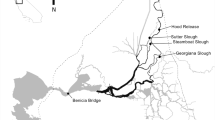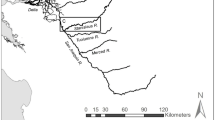Abstract
Populations of juvenile salmon emigrating from natal rivers to the ocean must often traverse different migratory pathways that may influence survival. In regulated rivers, migration routes may consist of a network of channels such as in the Sacramento-San Joaquin River Delta, or of different passage structures at hydroelectric dams (e.g., turbines or spillways). To increase overall survival, management actions in such systems often focus on altering the migration routing of fish to divert them away from low-survival routes and towards high-survival routes. Here, we use a 3-year data set of route-specific survival and movement of juvenile Chinook salmon in the Sacramento-San Joaquin Delta to quantify the sensitivity of survival to changes in migration routing at two major river junctions in the Sacramento River. Our analysis revealed that changes in overall survival in response to migration routing at one river junction depended not only differences in survival among alternative routes, but also on migration routing at the other river junction. Diverting fish away from a low-survival route at the downstream river junction increased population survival by less than expected, given the difference in survival among routes, because part of the population used an alternative migration route at the upstream river junction. We also show that management actions that influence only migration routing will likely increase survival by less than actions that alter both migration routing and route-specific survival. Our analysis provides an analytical framework to help fisheries managers quantify the suite of management actions likely to maximize increases in population level survival.





Similar content being viewed by others
References
Adams NS, Rondorf DW, Evans SD, Kelly JE, Perry RW (1998) Effects of surgically and gastrically implanted radio transmitters on swimming performance and predator avoidance of juvenile Chinook salmon (Oncorhynchus tshawytscha). Can J Fish Aquat Sci 55:781–787
Bracis C (2010) A model of the ocean migration of Pacific salmon. Thesis, University of Washington
Brandes PL, McLain JS (2001) Juvenile Chinook salmon abundance, distribution, and survival in the Sacramento-San Joaquin Estuary. In: Brown RL (ed) Contributions to the biology of Central Valley salmonids, volume 2, Fish Bulletin 179. California Department of Fish and Game, Sacramento, California, pp 39–138
Caswell H (2001) Matrix population models: construction, analysis, and interpretation. Sinauer Associates, Inc., Sunderland, Massachusetts
Coutant CC (2001) Behavioral technologies for fish guidance. American Fisheries Society, Bethesda, Maryland
Kostow KE (2004) Differences in juvenile phenotypes and survival between hatchery stocks and a natural population provide evidence for modified selection due to captive breeding. Can J Fish Aquat Sci 61:577–589
Newman KB, Brandes PL (2010) Hierarchical modeling of juvenile Chinook salmon survival as a function of Sacramento–San Joaquin Delta water exports. N Am J Fish Manage 30:157–169
Newman KB, Rice J (2002) Modeling the survival of Chinook salmon smolts outmigrating through the lower Sacramento River system. J Am Stat Assoc 97:983–993
Perry RW (2010) Survival and migration dynamics of juvenile Chinook salmon (Oncorhynchus tshawytscha) in the Sacramento-San Joaquin River Delta. Dissertation, University of Washington
Perry RW, Brandes PL, Sandstrom PT, Ammann A, MacFarlane B, Klimley AP, Skalski JR (2010) Estimating survival and migration route probabilities of juvenile Chinook salmon in the Sacramento–San Joaquin River Delta. N Am J Fish Manage 30:142–156
Reisenbichler RR, McIntyre JD (1977) Genetic differences in growth and survival of juvenile hatchery and wild steelhead trout, Salmo gairdneri. J Fish Res B Can 34:123–128
Skalski JR, Townsend R, Lady J, Giorgi AE, Stevenson JR, McDonald RD (2002) Estimating route-specific passage and survival probabilities at a hydroelectric project from smolt radiotelemetry studies. Can J Fish Aquat Sci 59:1385–1393
Skalski JR, Buchanan RA, Townsend RL, Steig TW, Hemstrom S (2009) A multiple-release model to estimate route-specific and dam passage survival at a hydroelectric project. N Am J Fish Manage 29:670–679
Acknowledgements
Funding for R.W.P’s involvement with this project was provided by a CALFED Science Fellowship, Agreement No. U-04-SC-005 with the California Bay-Delta Authority. Tagging of juvenile salmon, ultrasonic station deployment and interrogation, and tag-detection database maintenance were supported by a grant from the California Bay-Delta Authority by Agreement No. U-05-SC-047. We thank the staff of Coleman National Fish Hatchery for providing the late-fall Chinook and logistical support for this study. Staff of the Stockton U.S. Fish and Wildlife Office gratefully assisted with fish transportation and release. We thank two anonymous reviewers for comments that substantially improved this manuscript.
Author information
Authors and Affiliations
Corresponding author
Rights and permissions
About this article
Cite this article
Perry, R.W., Brandes, P.L., Burau, J.R. et al. Sensitivity of survival to migration routes used by juvenile Chinook salmon to negotiate the Sacramento-San Joaquin River Delta. Environ Biol Fish 96, 381–392 (2013). https://doi.org/10.1007/s10641-012-9984-6
Received:
Accepted:
Published:
Issue Date:
DOI: https://doi.org/10.1007/s10641-012-9984-6




